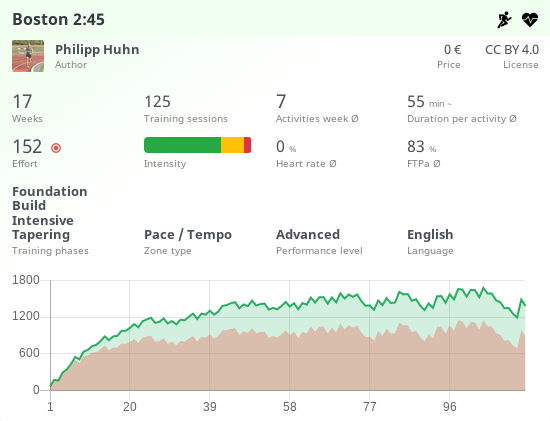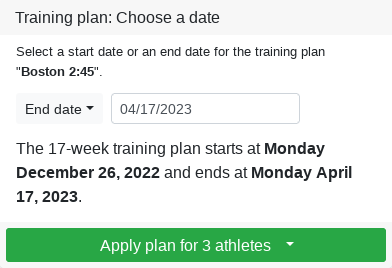Training plans
Training plans
With Tredict, you can create reusable training plans for endurance sports that you can optionally publish and even sell. You can transfer training plans published by other coaches into your portfolio so that you can apply these plans to yourself or your athletes.
Visit the public training plan directory for endurance athletes.

Applying a training plan
After transferring a training plan to your portfolio or if you have created your own plan, you can apply it to your training calendar.
Automatic intensity adjustment to the athleted
The special feature about Tredict training plans is the relative intensity distribution, which is automatically converted to the athlete's capacity when a plan is used. For example, the relative 75% hrMax defined in the plan becomes an absolute 135bpm heart rate in your training calendar if you have entered an hrMax of 180bpm in your capacity.
It is always a good idea to define your own capacity and zone settings, otherwise the Tredict defaults will be used.
Read the blog article: How the zones influence the effort
Start date
When a start date is specified, the first workout of a schedule is copied to the start date and the schedule is rolled out further into the calendar accordingly.
End date
If the training plan ends with a competition, it may be useful to specify an end date instead of a start date. This makes it possible to use the training plan for a fixed race date.
Simultaneous multiple application
As a trainer, you often have several endurance athletes that you coach. The Tredict training plans can be applied to several athletes simultaneously, which saves you some work.

Undo training plan application
In the application history of the training plan, you will find the option to undo the application of the training plan. This will remove all scheduled workouts of the training plan from the athlete calendar or your own calendar, even if they have already been changed. So be careful.

Creating a training plan
Create and distribute your own training plans for all popular endurance sports, such as running, cycling, swimming, triathlon and many more. You can offer your training plans for sale with the Tredict sales licence, publish them under a "Creative Commons" licence or simply leave them "private". Of course, you can still apply private training plans to your associated athletes.
Training plans can be published as soon as you have made the necessary entries in your public trainer profile.
Performance levels
Your training plans can have different performance levels to suit beginners as well as professionals.
- Everyone
The training plan is equally suitable for all performance levels. - Beginners
Newcomers or those returning to endurance sports will find this plan a suitable composition. - Advanced
Athletes with some experience and a good level of endurance can progress with these plans. - Professional
This plan is aimed at ambitious athletes and professionals who already have a high level of endurance and can tolerate higher volumes.
Zone types
Using the Tredict zone types, it is possible to create Watt-based plans or plans that are oriented according to speed or heart rate.
- Pace / Tempo
The intensities and efforts of the plan are calculated using the speeds of the workouts. - Heart rate
The intensities and efforts of the plan are based, among other things, on the heart rate during training. A heart rate monitor is required. - Power
The intensities and efforts of the plan are calculated according to wattage, among other things. A power measurement device is required during training.
Training phases
Define training phases on the plan so that the athlete knows what your training plan is aiming at.
- General
In this phase, various principles are followed that cannot be assigned to the other training phases. - Foundation
The foundation phase takes care of the important basic endurance and subsequently prepares the basis for further more specialised training phases. - Build
In the build-up phase, volumes are increased and specialised units are added. The build-up phase takes the momentum of the foundation phase, builds on it and leads purposefully to the intensive phase or the seasonal plateau. - Intensive
In the intensive phase of a training season, the main aim is to add endurance, speed and efficiency to what is already there. The volumes remain high. High-intensity sessions and other specific workouts are regularly added. - Tapering
Race preparation is characterised by reduced volumes and tapering. Sometimes special training sessions are added to increase efficiency. - Plateau
In the seasonal plateau, the important competitions are held, for which the other training phases were used for targeted training. The strenuous competitions are given weight through sufficient recovery, while the next competition is prepared for with training sessions that keep up the form. - Recovery
The recovery phase or off-season is used for long-term regeneration after the hard race season. The distances and intensities are lower. - Special
The special phase is a general special category for special training concepts, such as those found in ultramarathon training.
License
Choose from different licences if you want to publish your plan. There are 2 commercial distribution licences available to you and the "Creative Commons" licences, which are well suited for free distribution.
- None (private)
Not published - Tredict sales licence
Tredict sales licence - Tredict partner licence
Tredict partner licence - CC BY 4.0
Attribution - CC BY SA 4.0
Attribution - Sharing under the same conditions - CC BY NC 4.0
Attribution - Non-commercial - CC BY NC SA 4.0
Attribution - Non-commercial - Sharing under the same conditions - CC BY ND 4.0
Attribution - No derivative works - CC BY NC ND 4.0
Attribution - Non-commercial - No derivative works
Planning calendar
The planning calendar for training plans works in principle in the same way as you know it from your own Tredict calendar, except that here you work with fictitious days. The intensity distribution is in the focus here and you can develop the form curve of the plan according to your requirements. Each training plan starts with "Day 1" in the planning calendar. Later, when the plan is transferred to a real training calendar, the days are converted to a date accordingly.
Zones & Capacity
Each training plan has its own dedicated zone & capacity revisions. You can, with one click, transfer your own current revision into the plan and then adjust it accordingly. If you do not specify your own zones and capacities, the Tredict defaults will be used, which may not match the performance level of the training plan.
An unapplied plan uses its zone revisions to calculate the intensity distribution of the training sessions. In the later application by an athlete, the athlete's own zone revisions are then used again. This then possibly leads to a deviating intensity distribution in the athlete's calendar. Conceptually, this is intentional and also makes sense due to the conversion of the absolute values of a training session by means of the relative information in the plan.

Embed and share
Embed your training plans into your own website. You will find an HTML code that you can copy. If you are even more tech-savvy and want to be flexible, you can even dynamically process a JSON link and apply your own styles to the training plan.